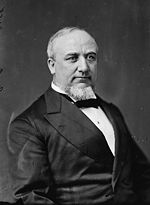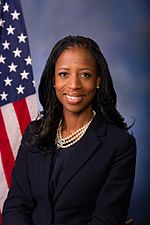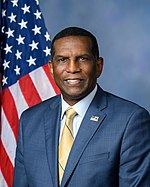
Since Hawaii became a state in 1959, it has sent congressional delegations to the United States Senate and United States House of Representatives. Each state elects two senators to serve for six years. Members of the House of Representatives are elected to two-year terms, one from each of Hawaii's congressional districts. Before becoming a state, the Territory of Hawaii elected a non-voting delegate at-large to Congress from 1900 to 1958.

Christopher Black Cannon is an American politician who formerly served as a member of the United States House of Representatives, for the Republican Party, representing the third district of Utah from 1997 to 2009.
Since Arkansas became a U.S. state in 1836, it has sent congressional delegations to the United States Senate and United States House of Representatives. Each state elects two senators to serve for six years, and members of the House to two-year terms. Before becoming a state, the Arkansas Territory elected a non-voting delegate at-large to Congress from 1819 to 1836.
Since Idaho became a U.S. state in 1890, it has sent congressional delegations to the United States Senate and United States House of Representatives. Each state elects two senators to serve for six years, and members of the House to two-year terms. Before becoming a state, the Idaho Territory elected a non-voting delegate at-large to Congress from 1864 to 1890.
Since Montana became a U.S. state in 1889, it has sent congressional delegations to the United States Senate and the United States House of Representatives. Each state elects two senators to serve for six years. Before the Seventeenth Amendment took effect in 1913, senators were elected by the Montana State Legislature. Members of the House of Representatives are elected to two-year terms, one from Montana's at-large congressional district. Before becoming a state, the Territory of Montana elected a non-voting delegate at-large to Congress from 1864 to 1889.

These are tables of congressional delegations from Indiana to the United States House of Representatives and the United States Senate.
Since Iowa became a U.S. state in 1846, it has sent congressional delegations to the United States Senate and United States House of Representatives. Each state elects two senators to serve for six years, and members of the House to two-year terms. Before becoming a state, the Iowa Territory elected a non-voting delegate at-large to Congress from 1838 to 1846.

The Cannon family is a prominent U.S. political family in the states of Utah, Nevada and Idaho which descends from the 19th century marriage of George Cannon and Ann Quayle before their emigration from Peel, Isle of Man. The family's most notable member was their oldest son George Q. Cannon. The family is connected by marriage to the Bennion, Taylor, Wells and Young political families.

Frank Jenne Cannon was the first United States Senator from Utah, who served from 1896 to 1899.
Utah Territory's at-large congressional district is an obsolete congressional district that encompassed the area of the Utah Territory. After Utah's admission to the Union as the 45th state by act of Congress on January 4, 1896, this district was dissolved and replaced by Utah's at-large congressional district.

The 2010 United States Senate election in Utah took place on November 2, 2010, along with other midterm elections throughout the United States. Incumbent Republican U.S. Senator Bob Bennett was seeking re-election to a fourth term, but lost renomination at the Republican Party's state convention. Mike Lee proceeded to win the Republican primary against Tim Bridgewater and the general election against Democrat Sam Granato. As of 2024, this is the most recent U.S. Senate election in which a political party held the seat after denying renomination to the incumbent senator.

The 1898–99 United States Senate elections were held on various dates in various states. As these U.S. Senate elections were prior to the ratification of the Seventeenth Amendment in 1913, senators were chosen by state legislatures. Senators were elected over a wide range of time throughout 1898 and 1899, and a seat may have been filled months late or remained vacant due to legislative deadlock. In these elections, terms were up for the senators in Class 1.

The 2012 United States House of Representatives elections in Utah were held on Tuesday, November 6, 2012 and elected the four U.S. representatives from the state of Utah, an increase of one seat in reapportionment following the 2010 United States census. The elections coincided with the elections of other federal and state offices, including a quadrennial presidential election and an election to the U.S. Senate. Primary elections were held on June 26, 2012.

The 2014 United States House of Representatives elections in Utah were held on November 4, 2014 to elect the four U.S. representatives from Utah, one from each of the state's four congressional districts. Representatives are elected for two-year terms; those elected would serve in the 114th Congress from January 2015 until January 2017.

The 2018 United States Senate election in Utah took place on November 6, 2018, to elect a member of the United States Senate to represent the State of Utah, concurrently with other elections to the United States Senate, elections to the United States House of Representatives, and various state and local elections. The primaries took place on June 26.

The 2018 United States House of Representatives elections in Utah were held on November 6, 2018, to elect the four U.S. representatives from the state of Utah, one from each of the state's four congressional districts. The elections coincided with other states' elections to the House of Representatives, elections to the United States Senate and various state and local elections. Registered political parties in Utah must have at least one of their candidates for House of Representatives get 2% of the vote in their respective election in order to maintain their ballot access in future elections.

After previously stating that he would not run for re-election, Jason Chaffetz announced on May 19 that he was resigning his seat in the House, effective June 30. A special election was called to replace him with a filing period opening on May 19 and closing by June 30, an expected primary date of August 15, and an election day of November 7.

The 2020 United States House of Representatives elections in Utah was held on November 3, 2020, to elect the four U.S. representatives from the state of Utah, one from each of the state's four congressional districts. The elections coincided with the 2020 U.S. presidential election, as well as other elections to the House of Representatives, elections to the United States Senate and various state and local elections.

The 2024 United States Senate election in Utah will be held on November 5, 2024, to elect a member of the United States Senate to represent the state of Utah. Incumbent Republican Senator Mitt Romney was elected with 62.6% of the vote in 2018 and has declined to seek a second term. Utah is considered a safe red state by election analysts; no Democrat has served in the Senate from the state since Frank Moss left office in 1977. Primary elections will take place on June 25, 2024.

The 2022 United States House of Representatives elections in Utah were held on November 8, 2022, to elect the four U.S. representatives from the state of Utah, one from each of the state's four congressional districts. The elections coincided with other elections to the House of Representatives, elections to the United States Senate and various state and local elections.





































